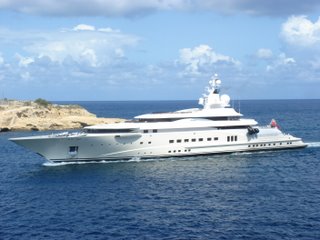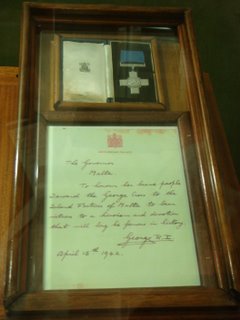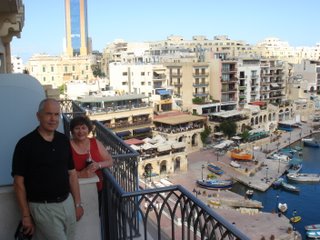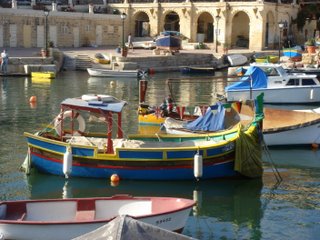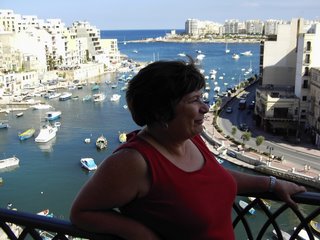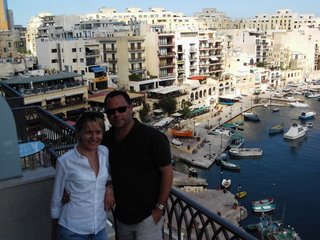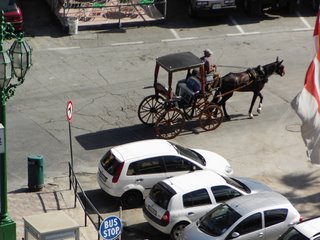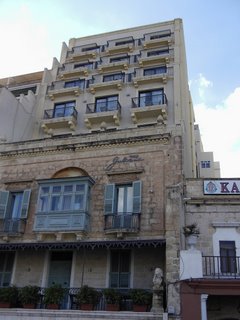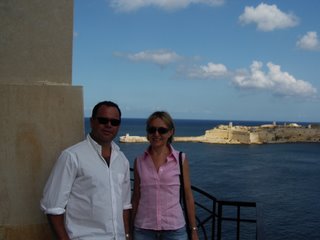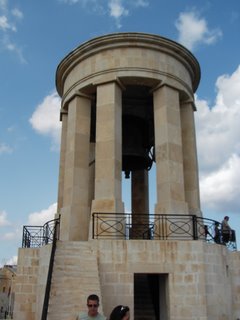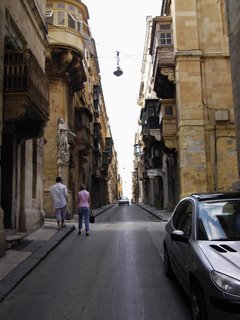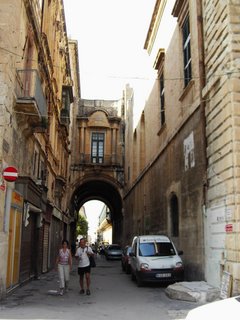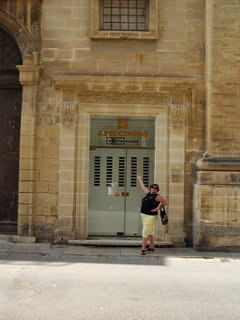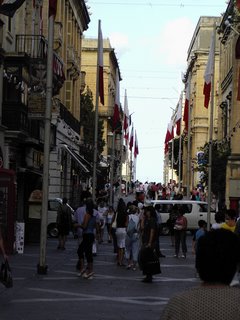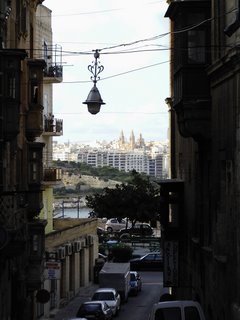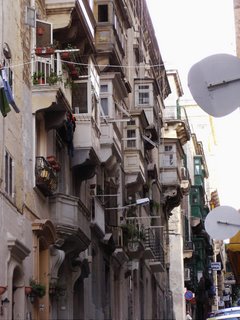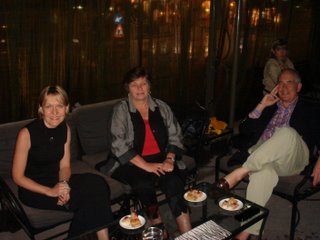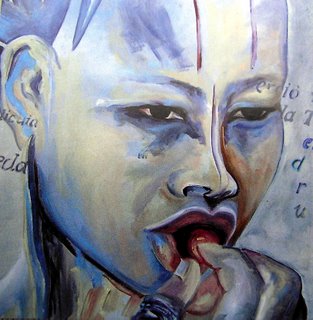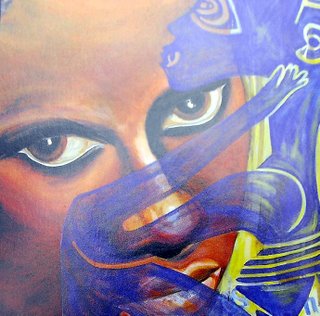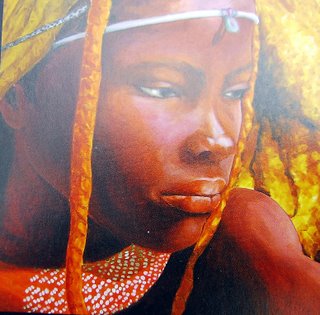The Silent City of Mdina
Adam and Rosalind went for an early morning run around the bays and told us that it was a lot easier than Positano as it was very flat and the pavements were very broad and a slight breeze off the sea made it very enjoyable. While they were doing that I exercised my pillow.
After breakfast our first objective was the city of Mdina:
‘The jewel in the crown of central Malta and an absolute must see, is Mdina, once the ancient walled capital of Malta. It is a stunning town perched loftily on a crag about ten kilometres west of Valletta, and its quiet streets ooze history and refinement. In the early morning and late afternoon, especially, this is the kind of place that has you talking in whispers so as not to disturb the peace.’ We were no exception and found ourselves talking in hushed voices and walking softly, just luxuriating in the peaceful atmosphere.
‘Mdina has a population of only 370 people and included in that is a closed order on nuns, who once they enter they never leave for any reason and are in fact buried within the walls of the order when they die. The citadel of Mdina was fortified from the early days of recorded history. As long ago as 1000 BCE the Phoenicians had built a protective wall here and called their settlement Malet, meaning ‘place of shelter’. The Romans built a large town here and called it Melita (which I think means honey for which it was famous). It was given its present name when the Arabs settled here in the 9th century – Madina is Arabic for ‘walled city’. They built strong walls and dug a deep moat between Mdina and the nearby town,350 metres away, just outside the city walls, known as Rabat.
In medieval times Mdina was also known as Citta Notabile – the Noble City. It was a favoured residence of the Maltese aristocracy and the seat of the ‘universita’ or governing council. The Knights of St John, who were largely a sea-based force, made Grand Harbour and Valetta their centre of activity, and Mdina sank into the background as a retreat of the Maltese nobility. Today with its massive walls and peaceful, shady streets, it is often referred to as the silent city.
One of the major sites is St Paul’s Cathedral said to be built on the site of the villa belonging to Publius, the Roman Governor of Malta who welcomed St Paul in AD 60.
St Paul was shipwrecked while on his way to be tried in Rome, and was shipwrecked on the North East corner of Malta in a bay that is now known as St Paul’s bay and there is a large statue on a rock at the entrance to St Paul’s bay to commemorate this event. St Paul stayed for over three months and during that time converted the people of Malta to Christianity, with the Maltese people claiming that they were the first Christian nation.
Just outside the gate to Mdina
The gateway into Mdina
The main street of Mdina
href="http://photos1.blogger.com/x/blogger/7450/1861/1600/48698/PIC01565.jpg">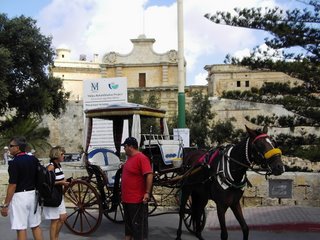
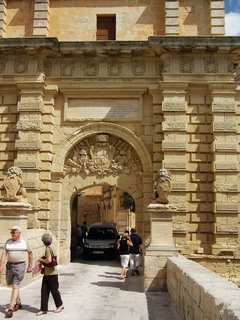
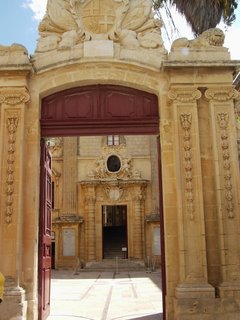
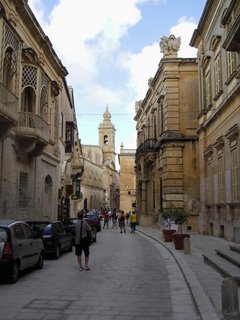
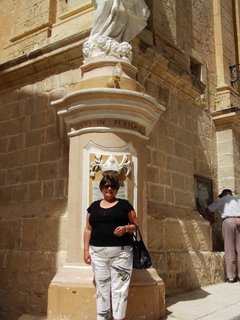
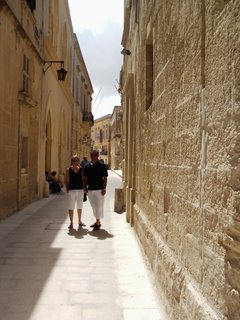
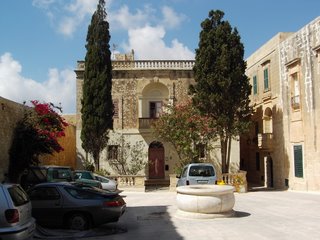
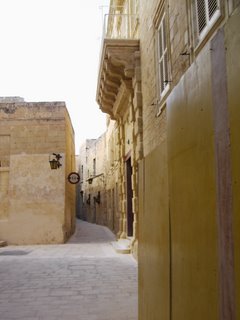 We had lunch at the outdoor restaurant of the Xara Palace hotel, the only hotel in Mdina and it is an exclusive five star hotel on one of Mdina’s 17th century palazzos. There are 17 luxury suites, each with cable TV, a stereo music centre and modem connection, though I expect that these modern communications ‘necessities’ would gather more dust than get a workout from guests enjoying the silence and peace that in Mdina. The hotel also has a gym, sauna, atrium bar and a rooftop fine dining restaurant.
We had lunch at the outdoor restaurant of the Xara Palace hotel, the only hotel in Mdina and it is an exclusive five star hotel on one of Mdina’s 17th century palazzos. There are 17 luxury suites, each with cable TV, a stereo music centre and modem connection, though I expect that these modern communications ‘necessities’ would gather more dust than get a workout from guests enjoying the silence and peace that in Mdina. The hotel also has a gym, sauna, atrium bar and a rooftop fine dining restaurant.
In keeping with Christian traditions there are memorials to many saints one of which is St Agatha, a 3rd century Christian martyr from Sicily – Catania and Palermo both claim to be her birthplace, who fled to Malta to escape the amorous advances of a Sicilian governor. On returning to Sicily she was imprisoned and tortured, and her breasts were cut off with shears, a horrific punishment that is gruesomely depicted, as Christians seem want to do, in many painting and statues in Malta. She was then burnt at the stake. There is a chapel dedicated to St Agatha in Mdina and catacombs in Rabat that are said to have been her hiding place in Malta.
www.geocities.com/maltatemples/.
href="http://photos1.blogger.com/x/blogger/7450/1861/1600/346941/PIC01599.jpg">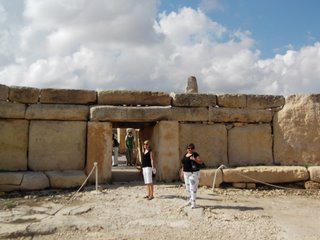
Sheila and Adam with Rosalind, in the background is the island of Filfla, 8 kms offshore.
It was used for target practice by the British armed forces until it was declared a nature reserve in 1970.It supports important breeding colonies of seabirds, including an estimated 10,000 pairs of storm petrels, and a unique species of lizard. Landing on the island is forbidden though I suspect that it is more to do with unexploded ordnance than protecting stormy petrels.
href="http://photos1.blogger.com/x/blogger/7450/1861/1600/725782/PIC01605.jpg">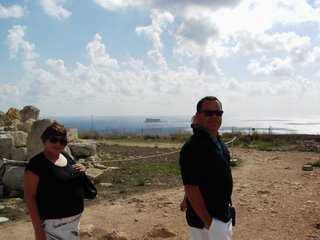 We were pleased to have seen the temples because of their age, but honestly I think that the are many other sites that are of more interest unless one is obsessed with megalithic stuff. Adam had organised the taxi to wait for us so we left quite soon and headed back to our hotel on the other side of the island, a trip that took about twenty minutes. We had a little siesta, Adam and Rosalind came to our room at 1855 to tell us that they had heard on the news that there had been a military coup in Thailand. It became quickly apparent that the coup had the tacit approval of the king and as such it would be successful as most Thais worship their king as the reincarnation of Vishnu and will follow his guidance without question. It seems that whenever we go on holiday there is always something of significance occurs. A couple of years ago we were in Phuket just about a week after the Tsunami.
We were pleased to have seen the temples because of their age, but honestly I think that the are many other sites that are of more interest unless one is obsessed with megalithic stuff. Adam had organised the taxi to wait for us so we left quite soon and headed back to our hotel on the other side of the island, a trip that took about twenty minutes. We had a little siesta, Adam and Rosalind came to our room at 1855 to tell us that they had heard on the news that there had been a military coup in Thailand. It became quickly apparent that the coup had the tacit approval of the king and as such it would be successful as most Thais worship their king as the reincarnation of Vishnu and will follow his guidance without question. It seems that whenever we go on holiday there is always something of significance occurs. A couple of years ago we were in Phuket just about a week after the Tsunami.
For dinner we went to another open air restaurant next door to the one we went to last night. This one is called ‘Paparazzi’ and is a prime people watching spot, with a great view of Spinola bay. It is a bit kitsch having such things as a ‘Cheeky Chick Burger’, and ‘Octopussy Salad’, but it made a change and we all had hamburgers and chips to make a change from our normal exotic cuisine.
Wandering back to the hotel we had some gelato and watched CNN to get updates on the coup in Thailand and it confirmed Adam’s assessment that it would be a ‘bloodless’ coup and would not be a major problem for foreigners living in Thailand.
After breakfast our first objective was the city of Mdina:
‘The jewel in the crown of central Malta and an absolute must see, is Mdina, once the ancient walled capital of Malta. It is a stunning town perched loftily on a crag about ten kilometres west of Valletta, and its quiet streets ooze history and refinement. In the early morning and late afternoon, especially, this is the kind of place that has you talking in whispers so as not to disturb the peace.’ We were no exception and found ourselves talking in hushed voices and walking softly, just luxuriating in the peaceful atmosphere.
‘Mdina has a population of only 370 people and included in that is a closed order on nuns, who once they enter they never leave for any reason and are in fact buried within the walls of the order when they die. The citadel of Mdina was fortified from the early days of recorded history. As long ago as 1000 BCE the Phoenicians had built a protective wall here and called their settlement Malet, meaning ‘place of shelter’. The Romans built a large town here and called it Melita (which I think means honey for which it was famous). It was given its present name when the Arabs settled here in the 9th century – Madina is Arabic for ‘walled city’. They built strong walls and dug a deep moat between Mdina and the nearby town,350 metres away, just outside the city walls, known as Rabat.
In medieval times Mdina was also known as Citta Notabile – the Noble City. It was a favoured residence of the Maltese aristocracy and the seat of the ‘universita’ or governing council. The Knights of St John, who were largely a sea-based force, made Grand Harbour and Valetta their centre of activity, and Mdina sank into the background as a retreat of the Maltese nobility. Today with its massive walls and peaceful, shady streets, it is often referred to as the silent city.
One of the major sites is St Paul’s Cathedral said to be built on the site of the villa belonging to Publius, the Roman Governor of Malta who welcomed St Paul in AD 60.
St Paul was shipwrecked while on his way to be tried in Rome, and was shipwrecked on the North East corner of Malta in a bay that is now known as St Paul’s bay and there is a large statue on a rock at the entrance to St Paul’s bay to commemorate this event. St Paul stayed for over three months and during that time converted the people of Malta to Christianity, with the Maltese people claiming that they were the first Christian nation.
Just outside the gate to Mdina
The gateway into Mdina
The main street of Mdina
href="http://photos1.blogger.com/x/blogger/7450/1861/1600/48698/PIC01565.jpg">







 We had lunch at the outdoor restaurant of the Xara Palace hotel, the only hotel in Mdina and it is an exclusive five star hotel on one of Mdina’s 17th century palazzos. There are 17 luxury suites, each with cable TV, a stereo music centre and modem connection, though I expect that these modern communications ‘necessities’ would gather more dust than get a workout from guests enjoying the silence and peace that in Mdina. The hotel also has a gym, sauna, atrium bar and a rooftop fine dining restaurant.
We had lunch at the outdoor restaurant of the Xara Palace hotel, the only hotel in Mdina and it is an exclusive five star hotel on one of Mdina’s 17th century palazzos. There are 17 luxury suites, each with cable TV, a stereo music centre and modem connection, though I expect that these modern communications ‘necessities’ would gather more dust than get a workout from guests enjoying the silence and peace that in Mdina. The hotel also has a gym, sauna, atrium bar and a rooftop fine dining restaurant. In keeping with Christian traditions there are memorials to many saints one of which is St Agatha, a 3rd century Christian martyr from Sicily – Catania and Palermo both claim to be her birthplace, who fled to Malta to escape the amorous advances of a Sicilian governor. On returning to Sicily she was imprisoned and tortured, and her breasts were cut off with shears, a horrific punishment that is gruesomely depicted, as Christians seem want to do, in many painting and statues in Malta. She was then burnt at the stake. There is a chapel dedicated to St Agatha in Mdina and catacombs in Rabat that are said to have been her hiding place in Malta.
www.geocities.com/maltatemples/.
href="http://photos1.blogger.com/x/blogger/7450/1861/1600/346941/PIC01599.jpg">

Sheila and Adam with Rosalind, in the background is the island of Filfla, 8 kms offshore.
It was used for target practice by the British armed forces until it was declared a nature reserve in 1970.It supports important breeding colonies of seabirds, including an estimated 10,000 pairs of storm petrels, and a unique species of lizard. Landing on the island is forbidden though I suspect that it is more to do with unexploded ordnance than protecting stormy petrels.
href="http://photos1.blogger.com/x/blogger/7450/1861/1600/725782/PIC01605.jpg">
 We were pleased to have seen the temples because of their age, but honestly I think that the are many other sites that are of more interest unless one is obsessed with megalithic stuff. Adam had organised the taxi to wait for us so we left quite soon and headed back to our hotel on the other side of the island, a trip that took about twenty minutes. We had a little siesta, Adam and Rosalind came to our room at 1855 to tell us that they had heard on the news that there had been a military coup in Thailand. It became quickly apparent that the coup had the tacit approval of the king and as such it would be successful as most Thais worship their king as the reincarnation of Vishnu and will follow his guidance without question. It seems that whenever we go on holiday there is always something of significance occurs. A couple of years ago we were in Phuket just about a week after the Tsunami.
We were pleased to have seen the temples because of their age, but honestly I think that the are many other sites that are of more interest unless one is obsessed with megalithic stuff. Adam had organised the taxi to wait for us so we left quite soon and headed back to our hotel on the other side of the island, a trip that took about twenty minutes. We had a little siesta, Adam and Rosalind came to our room at 1855 to tell us that they had heard on the news that there had been a military coup in Thailand. It became quickly apparent that the coup had the tacit approval of the king and as such it would be successful as most Thais worship their king as the reincarnation of Vishnu and will follow his guidance without question. It seems that whenever we go on holiday there is always something of significance occurs. A couple of years ago we were in Phuket just about a week after the Tsunami.For dinner we went to another open air restaurant next door to the one we went to last night. This one is called ‘Paparazzi’ and is a prime people watching spot, with a great view of Spinola bay. It is a bit kitsch having such things as a ‘Cheeky Chick Burger’, and ‘Octopussy Salad’, but it made a change and we all had hamburgers and chips to make a change from our normal exotic cuisine.
Wandering back to the hotel we had some gelato and watched CNN to get updates on the coup in Thailand and it confirmed Adam’s assessment that it would be a ‘bloodless’ coup and would not be a major problem for foreigners living in Thailand.

